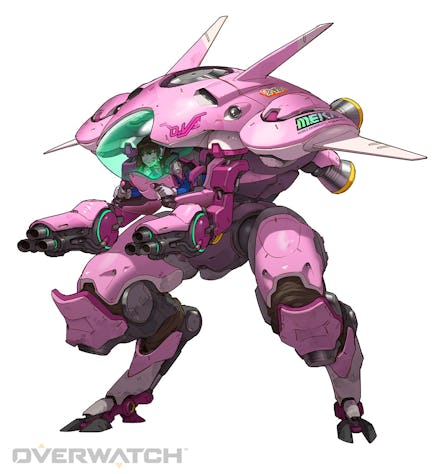How D.Va from 'Overwatch' changed my perspective on softer femininity

I used to describe myself as an "anti-pink activist." As a little girl with short hair and ripped jeans, I saw pink as the enemy. I played video games and coded websites. Pink was the gateway to a version of femininity that I just wasn't interested in embracing.
I didn't have Princess Peach when I was my daughter's age, and I didn't yet know that Samus Aran was a woman underneath her power armor. So Lara Croft was my heroine of choice. She didn't wear pink. She was too busy raiding tombs and kicking ass in khaki shorts and a blue tank top.
There were times when I got to play as a teal-shaded Spartan in Halo, but I actively avoided the pink. Pink was what the "other" girls would play as, if their boyfriends coerced them into participating in "Halo Saturdays." Pink was the color of frivolity.
Now, pink is a warrior color.
When I started playing Overwatch a little over year ago, I had no idea what kind of impact the game would have on the industry — let alone my wardrobe. But as I look at the pastel colors in my hair and the changes in my closet, there really has been a profound internal shift toward embracing softer femininity.
Being a "girl gamer" was hard, even if you didn't embrace the pink controllers
Before D.Va and Zarya became my gaming mainstays, I had these ridiculous notions of what it meant to be a "girl gamer." Between the tone-deaf marketing schemes, the cries from the community about "fake gamer girls" and pink being the default "girl color," I insulated myself. During my gaming sessions, I would turn off the voice chat or mask my gender whenever possible, unless I played with familiar people.
To me, it was bad enough to be a woman playing games without embracing the pink peripheral phenomenon. I had no desire to be a beacon of girliness if I showed up at a convention with my gaming rig or a spare controller. But in avoiding the trappings of femininity, I found myself scorning the women who floated through the gaming community on a pink cloud — somehow proud of their girliness.
It used to drive me crazy.
These were the days before I considered myself a feminist, before I saw how toxic the hardcore "girl gamers" like me were to the pink crowd. I saw them as interlopers, as a "them" instead of "us." It was divisive, unnecessary nonsense.
But even when I took up my intersectional feminist stripes, I still couldn't help but scoff at those clouds of pink as they dotted the walls at EB Games and GameStop, or popped up in my Twitter stream. It was still a step toward that version of femininity that I'd always had problems embracing. It made me deeply uncomfortable.
Nothing like a hot pink MEKA and a badass bodybuilder to expand my palette
I've always favored tanks when I play games. In massively multiplayer online games like World of Warcraft and Star Wars: The Old Republic, I always chose the class that could soak the damage and keep the baddies away from the healers. So, when I entered my first Overwatch quick play match, of course I chose a tank.
But the only female character choices I had went against my irrational aversion to pink. There was Zarya, a body-building powerhouse, and D.Va, a cutesy girl in a mech. So, of course, I chose Zarya, questionable hair color choice and all. My first few matches were dismal. I hadn't played a first person shooter in so long that I'd forgotten how much time it took to really sink into the mechanics.
After a few weeks with the game (and many lost matches), I got comfortable switching characters and finding new ones to play in each class. When I watched Overwatch streams, I began to pay attention to D.Va.
The overt girliness in her aesthetic turned me off. I felt strange choosing her for the first time. I remember remarking, "I like mechs, so I'm sure I'll like the pink one," to no one at all.
But in no time at all, I found myself utterly charmed by her adorable one-liners and the way she interacted with other characters in-game. The more time I spent playing D.Va, the more I wanted to have little mementos of her scattered around my office. And the fact that D.Va's collectibles were mostly pink didn't seem to bother me anymore.
One day, I looked down at my pink jeans and realized that my lifelong aversion to pink was finally gone. Pink's frivolity was replaced with the signature color of one of my favorite game characters and memories I'd made with my friends while playing Overwatch.
In my future is a pink D.Va hoodie, complete with her adorable bunny insignia. Hell, my new gaming rig might even be pastel-heavy with an emphasis on the same girliness that I used to abhor.
And I have D.Va to thank for that.
More Overwatch news and updates
For more on Overwatch, check out the rest of what Mic has to offer. Here is an essay about how Efi Oladele was a missed opportunity for Overwatch, a deep dive into the issue of sexual harassment in Overwatch voice chat, an unintentionally hilarious infographic showing the most popular Overwatch characters in each state, a criticism of Blizzard's failures in its design of Symmetra and a dive into a cool trend on Tumblr that converts your most-played heroes into a psychedelic illustration.